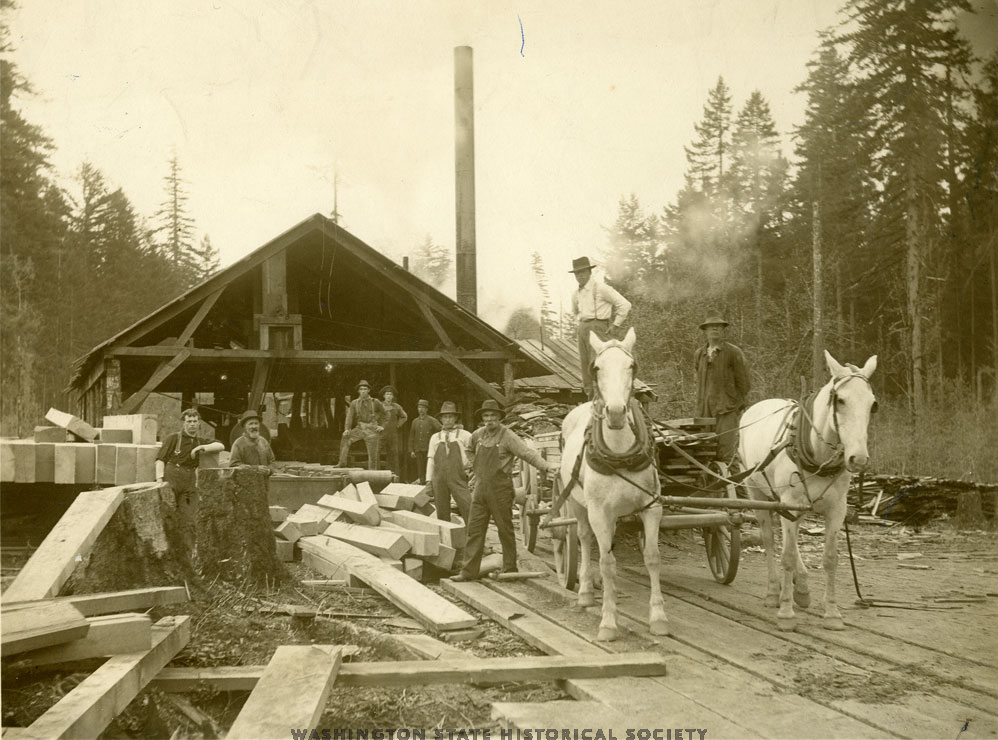I have spent hundreds of hours wandering the Black Hills, paddling Black Lake, and driving and cycling Black Lake Boulevard, and to be honest, I hadn’t thought much about the history of the area. I knew that thousands of years of human history sprawled behind me as a walked around my block, hiked to Capitol Peak, or watched the sunset on the lake, but I knew little of the people who have made their way here. Now that I have researched the history of Black Lake I will never be able to travel through my environment the same way. There are voices and stories everywhere out here. Join me as I explore the history, stories, and personalities of Black Lake.
 Native Americans inhabited the shores, prairies, and surrounding woodlands of Black Lake for many thousands of years. The early inhabitants of Black Lake and Black River fished, hunted, and gathered in the area. Black Lake and Black River were inhabited by members of the Upper Chehalis Tribe, but the area was likely shared by Upper Chehalis and Nisqually Tribes as lands in common. “The portage between Black lake and Puget Sound (Eld Inlet) was used so frequently that the ties between the Black River people and the Nisqually Village at Mud Bay on Eld Inlet were so close that this village has alternately been identifies as Upper Chehalis and Nisqually,” according to a report by the University of Washington Office of Public Archaeology.
Native Americans inhabited the shores, prairies, and surrounding woodlands of Black Lake for many thousands of years. The early inhabitants of Black Lake and Black River fished, hunted, and gathered in the area. Black Lake and Black River were inhabited by members of the Upper Chehalis Tribe, but the area was likely shared by Upper Chehalis and Nisqually Tribes as lands in common. “The portage between Black lake and Puget Sound (Eld Inlet) was used so frequently that the ties between the Black River people and the Nisqually Village at Mud Bay on Eld Inlet were so close that this village has alternately been identifies as Upper Chehalis and Nisqually,” according to a report by the University of Washington Office of Public Archaeology.
“The winter villages, probably, consisting of two to five plank houses, were partially abandoned in the spring, summer and fall, while the Black River people moved to favored camas and berry patches, hunted, fished, or travelled to Mud Bay for clams or Rainbow Falls for eels,” the report states.
Black Lake and Black River were commonly used as a travel route between Grays Harbor and Puget Sound, first by many Native American Tribes and, later, explorers, fur trappers, and white settlers.
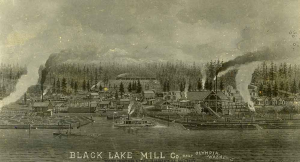
In 1792, the first whites travelled to the area on Captain George Vancouver’s historic voyage to Puget Sound. The first white man to write about Black Lake was John Work, Hudson’s Bay Company employee. He reported seeing salmon, beaver, deer, and elk. Many of the first Euroamericans to travel through the Black Lake area used the lake and river to travel between the Chehalis drainage and Puget Sound. In 1833, as a result of the establishment of Fort Nisqually, and the subsequent development of the Cowlitz Trail, the watery route connecting Black Lake to the Chehalis drainage and Puget Sound was largely abandoned to the overland Cowlitz Trail.
The mid-nineteenth century saw a large influx of new settlers to the Olympia area, with many homesteading the prairies south of Olympia. One of the first Black Lake pioneers on record was William O. Thompson, who was resided with famed pioneer George Washington Bush for several months before striking out on his own in 1852.
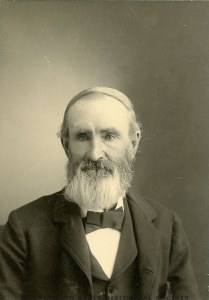
“I wanted to get a claim on Bush Prairie, but the good land was all taken. There was plenty of land to be had for the taking around Olympia, but the timber was so thick that I was afraid of it. It did not seem as if a man would live long enough to ever see a garden grow, so I heard of some good prairie land out at Black Lake,” Thompson was quoted as saying. “I had been much pleased with that lake, it was so picturesque and looked, to me, like the shape of a violin nestled down in the green; the slender place in the middle, about sixty rods wide, seemed as beautiful to me as a lady’s picture.”
Thompson, or “Blake Lake Thompson” as he came to be known, staked his claim and built his cabin on the West Shore of Black Lake, where the undeveloped Guerin County Park is today. ”I found a prairie one-half mile long and 80 to 100 rods wide, bordered with oak trees and a little fringe of fir around the lake. A beautiful little trout stream ran across one end of the prairie and into the lake. There were smelt in the creek at the last of the rainy season. Salmon would come up the creek to spawn and often, when I would go down to get a bucket of water, I would knock a salmon on the head with my ax, for my dinner.”
The early settlers of the Black Lake area were hearty homesteaders and intrepid loggers. By 1889 there were a reported 40 logging camps around Thurston County employing 1,800 men, and many of those camps were in the Black Hills. There were reportedly two major lumber mills at Black Lake, with the first one operating at the turn of the century. Few details are available regarding the first mill. The second mill, Black Lake Mill, opened in 1910, and was destroyed by fire and permanently closed in 1918.
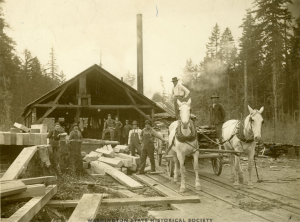
Due to four decades of intensive logging in the Black Hills and a series of devastating wild fires in the early twentieth century, commercial logging of the area dwindled, but continued until the 1940s. The State of Washington eventually acquired the exhausted timberland in the Black Hills, and today it is Capitol State Forest.
Memories, a history of Black Lake, Delphi, & Waddel Creek, complied by John Markham, contains extensive oral and written history of early Black Lake residents. These stories recount wild, difficult country were hard livings were made from the land while simultaneously describing tight-knit communities and carefree childhoods of swimming and exploring.
Geraldine (Gault) Fuller reported: “Life in a logging camp in the 1930s meant hard work and long hours for both men and women. Since electricity was nonexistent, much effort was put forth in canning and preserving foods for the winter months.”
John Markham wrote in the introduction to Tons of memories: Black Lake, Delphi, Waddell Creek School pictures & history: “After the logging was completed in this area, many people left. Some farmers stayed, but found it difficult to make a living in the depression years. Only a handful of people stayed–the original settlers who had homesteaded.”
Longtime resident Lila (Lehman) Jones wrote: “The happiest days of my childhood were while living at ‘The Orchard’ (now Columbus Park), swimming, every day, a short walk to school and on the weekends a refreshment stand was set up around a maple tree where ice cream, pop, and candy was sold…in the mid twenties my folks sold ‘the Orchard’ to the Knights of Columbus.”
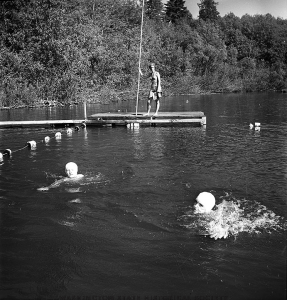
courtesy: Washington State Historical Society
As logging began to dwindle, more amenities were added to the Black Lake communities. A schoolhouse was established at the turn of the nineteenth century, and a more permanent structure was built in 1910. The 1910 schoolhouse, now the historic Black Lake Grange, operated until the mid 1940s. The first grocery store was established in the early 1920s, on the site of the current day Black Lake Grocery, and Columbus Park officially opened in 1926, though the park had been used as a campground even earlier.
Today Black Lake is home to many, while the surrounding area, like Delphi and Capitol Forest, still retain their rural, wild character. Next time you stroll through Capitol Forest and observe a massive stump imagine the intrepid loggers who worked to make a life here. When you admire a sunrise or sunset from Black Lake Boulevard or cast a line in Black Lake, try to picture the lake so full of fish that one could catch a fish by “knocking a salmon with an ax.” Imagine the Chehalis hunting, fishing, gathering and wintering on these shores, and “Black Lake” Douglas and subsequent pioneers homesteading the shores.







































